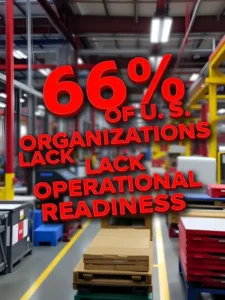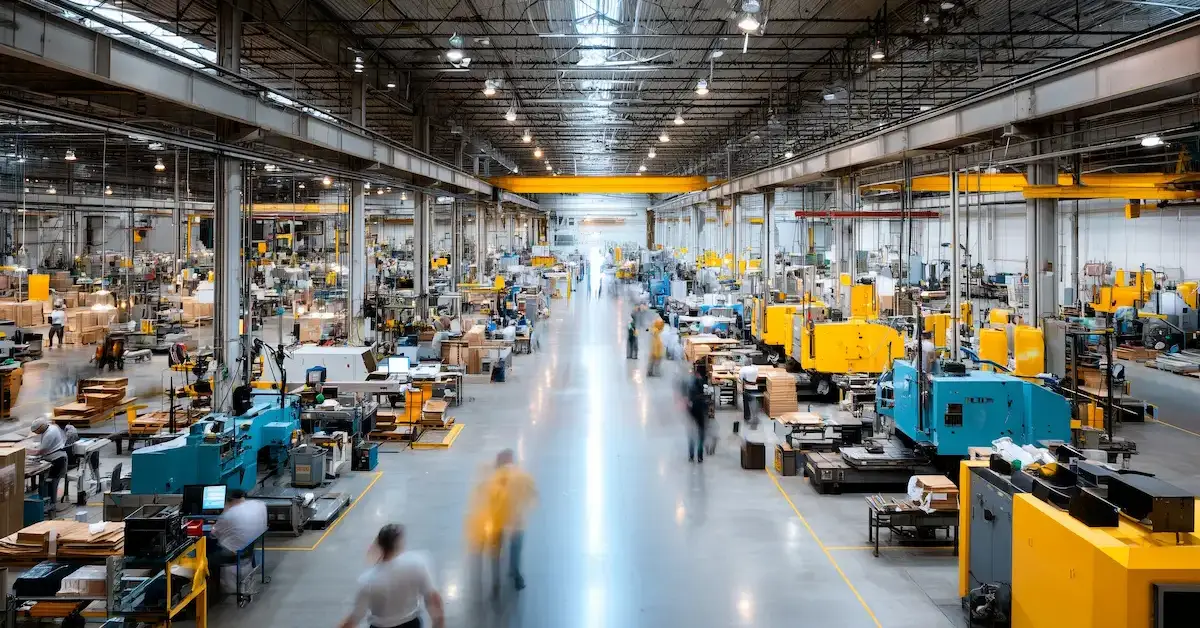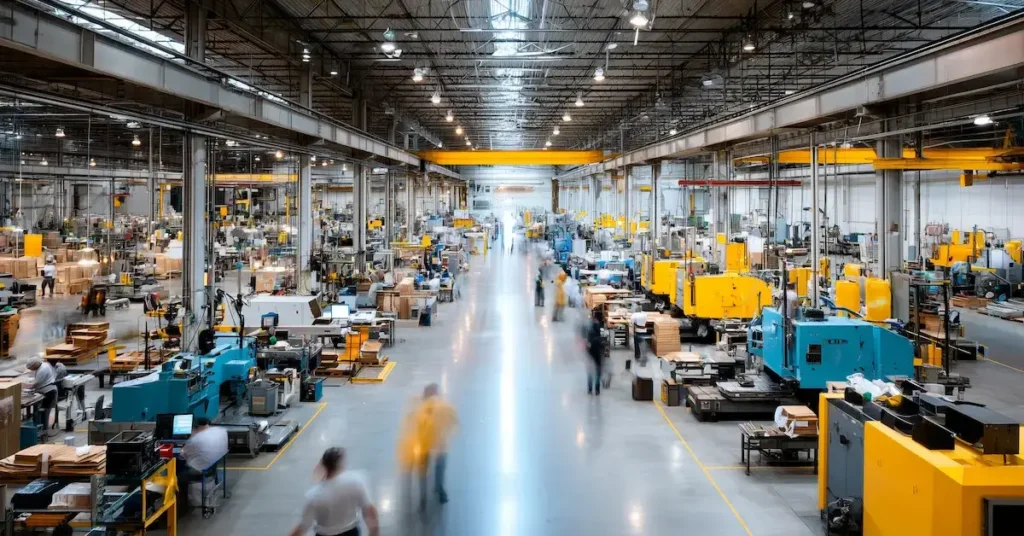Two-thirds of U.S. manufacturers are unprepared for manufacturing automation readiness, operational readiness advanced automation, manufacturing automation strategy planning, advanced automation deployment, and manufacturing strategy planning. That’s data, not opinion—from Gartner’s recent survey of 128 manufacturing and supply chain leaders.
The statistics reveal an uncomfortable truth. Nearly half (49%) of organizations lack confidence in their manufacturing strategy planning to deliver business outcomes over the next three years. Even more troubling: 66% identify integrating supply chain and manufacturing as their biggest operational challenge.
“We encounter this gap daily when analyzing prospect operations,” says Ed Romaine, VP of Marketing and Business Development at ISD. “Companies recognize they need manufacturing automation readiness . They’ve read about AI and autonomous robots. But when we ask about their implementation roadmap and operational readiness, most conversations stall. Organizations haven’t connected their automation vision to their actual operational reality.”
The Manufacturing Strategy Planning Confidence Crisis

Organizations reporting to CSCOs demonstrate 68% stronger alignment in investment coordination and supply chain integration compared to those under chief operating officers. That performance gap directly impacts operational readiness and advanced automation deployment.
The robotics market data tells a contrasting story. North American companies ordered 17,635 robots valued at $1.094 billion in the first half of 2025 (Association for Advancing Automation, 2025). Automotive OEMs led adoption with a 34% year-over-year increase. Other segments showing growth include plastics and rubber (up 9%) and life sciences/pharma/biomedical (up 8%).
Here’s the disconnect: robot orders climb while operational readiness advanced automation falls. Equipment availability isn’t the constraint—organizational preparedness is.
Understanding Advanced Automation Adoption Realities
Global robot installations reached 500,000 units for the fourth consecutive year (International Federation of Robotics, 2025). Asia accounts for 74% of deployments, Europe 16%, and the Americas just 9%. The United States installed 34,200 robots in 2024—representing 68% of all installations in the Americas.
Most robots deployed in U.S. facilities come from Japanese and European manufacturers. Few domestic suppliers exist, though numerous systems integrators like ISD implement these solutions across warehouse, distribution, and manufacturing operations.
“Equipment availability isn’t your problem,” explains Tony Morgott, VP of Sales at ISD. “You can purchase robots tomorrow. The challenge is operational readiness. You can’t install AI and autonomous systems into legacy command-and-control operating models and expect ROI. Your operating models must evolve first.”
Collaborative robots (cobots) demonstrate promising adoption. Orders reached 3,085 units valued at $114 million in the first half of 2025 (A3 Robotics Industry Data, 2025). In Q2 alone, cobots represented 23.7% of all units and 14.7% of revenue. These systems work safely alongside humans—ideal for space-constrained or labor-limited environments.
The Three-Year Manufacturing Strategy Planning Outlook
Manufacturing and manufacturing strategy planning’s sentiment remains cautiously optimistic yet stressed. The National Association of Manufacturers (NAM) reports 65% optimism in Q3 2025, up from 55.4% in Q2 (NAM Outlook Survey, Q3 2025).
Three familiar concerns intensified:
- Trade uncertainty: 78.2% (up from 77.0%)
- Rising raw material costs: 68.1% (up from 66.1%)
- Increasing health care costs: 65.1% (up from 60.0%)
The Institute for Supply Management (ISM) Manufacturing PMI registered 48.7% in August 2025—marking six consecutive months of contraction (ISM Manufacturing Report, August 2025). Production output returned to contraction territory. Employment edged up slightly as companies manage headcount rather than expand hiring.
“These economic pressures make strategic manufacturing automation readiness even more critical,” Morgott emphasizes. “When you can’t find labor and costs keep climbing, automation becomes essential. But most companies attempt to automate broken processes. That approach fails. You need operational readiness—optimizing operations first, then deploying automation where it delivers measurable ROI.”
Global Manufacturing Automation Readiness: Where Competitors Are Advancing

The Chinese manufacturing automation strategy could average 10% annual growth through 2028. Robot demand shows no indication of decreasing.
Other Asian market installations:
- Japan: 44,500 units (down 4%, still second-largest market)
- South Korea: 30,600 units (down 3%, fourth-largest globally)
- India: 9,100 units (up 7%, continuing record growth)
Europe recorded 85,000 installations in 2024—an 8% decline but still the second-highest on record. Germany leads European markets with 26,982 units (down 5%). Italy dropped 16% to 8,783 units. France fell 24% to 4,900 units. The UK declined 35% to 2,500 units.
The Americas exceeded 50,000 units for the fourth consecutive year. Mexico reached 5,600 units (down 4%). Canada declined 12% to 3,800 units.
The International Federation of Robotics projects global installations will grow 6% to 575,000 units in 2025 and surpass 700,000 units by 2028.
What High-Performing Organizations Do Differently for Operational Readiness
Leading manufacturers restructure operating models by aligning them to future-oriented capabilities. They remove legacy roadblocks across value streams, governance structures, and resource allocation.
Gartner recommends three specific actions for CSCOs pursuing advanced automation:
 1. Reset Expectations and Operating Models for Plant Managers
1. Reset Expectations and Operating Models for Plant Managers
Plant leaders must transition from command-and-control oversight to AI-driven data analytics and performance optimization. This requires addressing legacy mindsets, empowering shop floor teams for decentralized decisions, and providing targeted digital training.
“We’ve implemented hundreds of automation projects over 60 years,” says Ed Romaine. “Projects succeed when executives commit to operational redesign. Projects struggle when organizations try automating around resistance. That’s expensive and ineffective. Operational readiness advanced automation must precede equipment installation.”
2. Modernize and Standardize Production Systems
Enhance production systems by integrating emerging technologies and strengthening site integration. Coordinate capability building by aligning site initiatives with digitalization efforts. Strengthen standards and accountability through KPIs and training programs.
This modernization extends beyond the manufacturing automation strategy to its warehouse and distribution operations. ISD’s OptimalOps-Process™ addresses this by analyzing current state operations, identifying bottlenecks, and designing solutions that optimize processes before automation deployment.
3. Reallocate Decision Rights for Enhanced Operational Readiness
Move decision authority closer to execution points. Support this transition with advances in AI, robotics, and automation. Empower shop floor teams to make faster, informed decisions through formal governance and targeted programs.
These aren’t suggestions—they’re requirements for manufacturing automation readiness and success. Systems integrators like ISD work with clients to build this operational readiness advanced automation before recommending specific equipment solutions.
The Non-Automotive Sector Manufacturing Automation Readiness Surge
A significant shift occurred in Q2 2025: non-automotive sectors accounted for 56% of total robot units ordered (A3 Data, Q2 2025). This reflects expanding manufacturing automation strategy adoption in life sciences, electronics, food and beverage, and other segments beyond traditional automotive applications.
Automotive OEMs maintain leadership with their 34% growth rate. But diversification across industries signals market maturation. More sectors recognize manufacturing automation readiness as central to long-term business strategy rather than optional efficiency enhancement.
“Five years ago, automotive dominated our project pipeline,” Romaine notes. “Today, we design automated systems for food and beverage, healthcare, electronics, 3PLs, and retail distribution—industries that traditionally relied on manual processes. Labor shortages and operational efficiency demands drive this shift. Companies that previously delayed automation are now rapidly accelerating its implementation.”
Why Most Manufacturers Lack Operational Readiness
The data exposes an uncomfortable reality: despite manufacturing automation readiness enthusiasm, most organizations lack the operational foundation for success and their manufacturing strategy planning is inadequate.
Legacy organizational designs emphasize cost control over agility. This blocks the responsiveness needed to capitalize on market opportunities. Without governance model evolution, even substantial automation investments underperform expectations.
Manufacturing automation strategy activity contracted for six straight months through August 2025. The ISM Production Index confirms continuing output challenges. Supplier deliveries slowed. Inventories remained in contraction territory.
Yet robot orders keep climbing. This divergence suggests companies purchase automation without solving underlying operational issues.
“We analyze customer operations comprehensively before recommending equipment,” explains Romaine. “Maybe 30% of prospects demonstrate operational readiness advanced automation. The other 70% need process optimization first. ISD’s OptimalOps-Process™ addresses this fundamental issue—we optimize the operational foundation before installing automation. Otherwise, you’re automating inefficiency, which amplifies problems rather than solving them.”
The Strategic Path Forward: Building Manufacturing Strategy Planning on Operational Readiness
Global manufacturing confronts persistent uncertainty. Trade policies shift frequently. Raw material costs escalate. Healthcare expenses increase. Manufacturing output barely exceeds 2017 averages despite significant automation investment.
The solution isn’t purchasing more robots. The solution requires strategic operational redesign combined with purpose-driven manufacturing automation readiness and deployment.
Organizations must align manufacturing capabilities with business outcomes. They need governance models supporting AI and robotics adoption. They require empowered plant managers making data-driven decisions rather than relying on intuition and legacy approaches.
“ISD partners with clients using an OEM-agnostic approach,” Romaine explains. “We’re not tied to specific equipment vendors. This independence lets us recommend the best solutions for your specific operational requirements. Our 60 years of experience taught us that operational readiness advanced automation determine success far more than equipment selection. We build that foundation through our OptimalOps-Process™, then deploy automation with clear ROI targets and verified performance metrics.”
The robotics market will continue expanding. IFR projects steady growth despite macroeconomic headwinds. Organizations installing automation today position themselves advantageously for tomorrow’s competitive landscape.
However, this is only possible if they first establish the operational foundation. Manufacturing strategy must precede equipment procurement. Operational readiness advanced automation must come before advanced automation deployment. Operating models must evolve before technology installation.
Integrating Warehouse and Distribution Automation with Manufacturing Strategy Planning
The 66% of organizations citing supply chain and manufacturing integration as their most significant challenge face a critical operational readiness advanced automation gap. Manufacturing automation readiness can’t succeed in isolation—it must connect seamlessly with warehouse automation, distribution systems, and order fulfillment operations.
This integration challenge extends across:
- Automated Storage and Retrieval Systems (ASRS) feeding manufacturing lines
- Autonomous Mobile Robots (AMRs) moving materials between production and warehousing
- Conveyor systems connecting manufacturing output to distribution operations
- Sortation systems channeling finished goods to fulfillment zones
- Warehouse software and management systems (MES, WMS, WES, and WCS) coordinate inventory and equipment with production schedules
Systems integrators specializing in both manufacturing automation readiness and warehouse automation—like ISD—address this integration challenge through comprehensive operational analysis. The OptimalOps-Process™ evaluates material flow across manufacturing, warehousing, and distribution operations to identify bottlenecks that automation can eliminate.
The Bottom Line on Manufacturing Automation Readiness
Sixty-six percent of U.S. organizations aren’t aggressively redesigning operations for advanced automation. Nearly half lack confidence in their three-year manufacturing strategy. Yet robot orders hit record levels and continue climbing.
This disconnect creates risk for unprepared organizations and opportunity for those taking strategic action on operational readiness.
“The companies succeeding with manufacturing automation readiness aren’t necessarily spending the most,” concludes Morgott. “They’re organizations that invested time understanding their operations, identified specific bottlenecks, designed solutions addressing root causes, and then—only then—deployed automation with clear ROI targets. That’s the difference between a successful manufacturing automation strategy and expensive experimentation.”
The data is clear. The opportunity is significant. The question isn’t whether to pursue advanced automation. The question is whether your organization has built the operational readiness and advanced automation to make manufacturing automation succeed.
Q&A: Common Questions About Manufacturing Automation Readiness
Q1: What percentage of manufacturers demonstrate operational readiness advanced automation?
A: According to Gartner’s 2025 survey of 128 manufacturing and supply chain leaders, only one-third of U.S. organizations are pursuing aggressive operational redesigns needed for advanced automation. Two-thirds lack adequate operational readiness, though many are still purchasing equipment.
Q2: How many robots are being installed globally, and what does the situation mean for manufacturing strategy planning?
A: Global robot installations exceeded 500,000 units annually for four consecutive years (IFR, 2025). The International Federation of Robotics projects growth to 575,000 units in 2025 and over 700,000 units by 2028. Despite this growth, operational readiness advanced automation lags behind equipment adoption, suggesting many organizations deploy technology without adequate manufacturing strategy planning and preparation.
Q3: What represents the most significant challenge manufacturers face with automation integration?
A: Sixty-six percent of survey respondents identify integrating supply chain and manufacturing as the most significant challenge for the next three years (Gartner, 2025). Legacy governance structures, command-and-control operating models, and insufficient operational readiness advanced automation create additional barriers to successful manufacturing automation strategy deployment.
Q4: Are robot orders increasing or decreasing in North America?
A: North American companies ordered 17,635 robots valued at $1.094 billion in the first half of 2025 (A3, 2025). Automotive OEMs showed 34% year-over-year growth. The trend remains strongly positive despite gaps in organizational operational readiness.
Q5: What industries beyond automotive are adopting manufacturing automation readiness?
A: Life sciences/pharma/biomedical (up 8%), plastics and rubber (up 9%), electronics, food and beverage, and 3PL distribution are all increasing robot adoption (A3 Industry Data, 2025). Non-automotive sectors accounted for 56% of Q2 2025 robot orders, reflecting broader manufacturing automation strategy adoption across diverse industries.
Q6: How does operational readiness advanced automation impact manufacturing automation strategy ROI?
A: Organizations with strong operational readiness—including optimized processes, data-driven operating models, and integrated systems—achieve significantly higher ROI from manufacturing automation strategy investments. Companies attempting to automate broken processes without operational readiness advanced automation typically experience cost overruns, extended implementation timelines, and underperforming systems.
Q7: What role do systems integrators play in building operational readiness?
A: Systems integrators like ISD conduct comprehensive operational analysis before recommending equipment. They identify process bottlenecks, optimize workflows, establish data collection frameworks, and ensure organizational readiness before automation deployment. This approach significantly increases project success rates compared to equipment-first strategies.
Q8: How long does it take to establish operational readiness advanced automation?
A: Timeline varies by current state maturity, but organizations typically require 3-6 months for comprehensive operational assessment, process optimization, and readiness preparation before advanced automation deployment. Rushing this phase to accelerate equipment installation usually extends overall project timelines and reduces ROI.
Q&A: Questions You Should Ask Before Implementing Manufacturing Automation Readiness
Q9: Has our organization completed a comprehensive operational analysis before selecting advanced automation technology?
A: Manufacturing automation readiness succeeds when it solves specific, measured operational bottlenecks. Without baseline data on throughput, accuracy, labor costs, space utilization, and process efficiency, you’re guessing rather than optimizing. Operational readiness advanced automation requires data-driven decision-making, not intuition-based equipment selection.
Q10: Do we have operating models and governance structures supporting decentralized, data-driven decision-making?
A: Legacy command-and-control operating models block manufacturing automation strategy effectiveness. Plant managers need authority and tools for AI-supported decisions at execution points. Your manufacturing strategy should define new decision frameworks before technology deployment.
Q11: What percentage of our manufacturing operations will machines handle in three years, and how does that compare to current state?
A: Leading organizations set clear targets (current industry average: 21% machine-handled operations, projected 32% in three years per Gartner data). Your manufacturing strategy planning roadmap should define specific milestones, metrics, and operational readiness gates rather than vague automation goals.
Q12: Have we aligned our supply chain and manufacturing integration strategy to support operational readiness?
A: Sixty-six percent of organizations cite integration as their top challenge. Address these gaps before deploying advanced automation that depends on seamless data flow between warehouse, manufacturing, and distribution operations. Systems integrators can evaluate your current integration maturity and identify requirements.
Q13: What’s our plan for modernizing production systems and building digital capabilities across sites?
A: Standardization enables manufacturing automation strategy scalability. Different systems at different facilities create ongoing integration challenges and limit advanced automation effectiveness. Your manufacturing strategy planning should include standardization roadmaps, not just equipment lists.
Q14: How will we reallocate decision rights to empower shop floor teams supported by AI and robotics?
A: Successful manufacturing automation strategy moves authority closer to execution. Define new decision frameworks, accountability structures, and training programs before technology deployment. Operational readiness advanced automation includes organizational change management, not just technical implementation.
Q15: Do we have verified ROI targets with documented assumptions for our manufacturing automation strategy investment?
A: Generic ROI claims need operational context. Your specific operation, current state maturity, and implementation approach determine actual returns. Work with experienced systems integrators to model realistic ROI based on your baseline data, not industry averages.
Q16: What’s our timeline from operational assessment through go-live, and does it account for organizational change management?
A: Technology installation happens relatively quickly. Organizational operational readiness advanced automation takes longer. Realistic timelines account for process optimization, operating model evolution, training, and cultural adaptation. Manufacturing strategy planning should align technology deployment with organizational readiness, not procurement schedules.
Q17: Have we selected a systems integrator with demonstrated expertise in both manufacturing automation strategy and operational readiness?
A: Equipment vendors sell technology. Systems integrators like ISD design solutions. Look for partners offering comprehensive operational analysis (like OptimalOps-Process™), OEM-agnostic equipment recommendations, proven integration expertise across warehouse and manufacturing operations, and documented success in your industry. Operational readiness advanced automation requires this strategic partnership approach.
Q18: How will we measure operational readiness advanced automation progress before, during, and after manufacturing automation strategy deployment?
A: Establish clear KPIs for operational readiness: process cycle times, quality metrics, inventory accuracy, labor productivity, space utilization, and system integration performance. Track these metrics throughout your manufacturing strategy planning and implementation to validate readiness and quantify improvement. Data-driven measurement ensures advanced automation delivers expected ROI.
Abour ISD – Integrated Systems Design
ISD is a leading systems integrator specializing in warehouse, distribution, and manufacturing operations with over 60 years of experience providing distribution and manufacturing strategy planning. As an OEM provider of the UltraStore Mid-Load ASRS system, ISD brings an OEM-agnostic approach to selecting the best automation solutions for each client’s unique operational requirements.
Our proprietary OptimalOps-Process™ features an 8-step framework designed to enhance operational efficiency, reduce costs, expedite ROI, and future-proof operations by optimizing picking, sorting, packing, and shipping processes before automation deployment.
ISD’s extensive offerings encompass Conveyor Systems, Automated Storage and Retrieval Systems (ASRS), Autonomous Mobile Robots (AMRs), Robotics, Sortation Systems, Warehouse Software, Pallet Handling, Packaging Automation, and comprehensive Order Fulfillment technologies.
We focus on working together with clients to set goals, analyze data thoroughly, and create plans that prepare them for successful manufacturing automation readiness.
For more information about building operational readiness advanced automation for your manufacturing automation readiness, email information@isddd.com or schedule a no-obligation consultation.


 1. Reset Expectations and Operating Models for Plant Managers
1. Reset Expectations and Operating Models for Plant Managers

